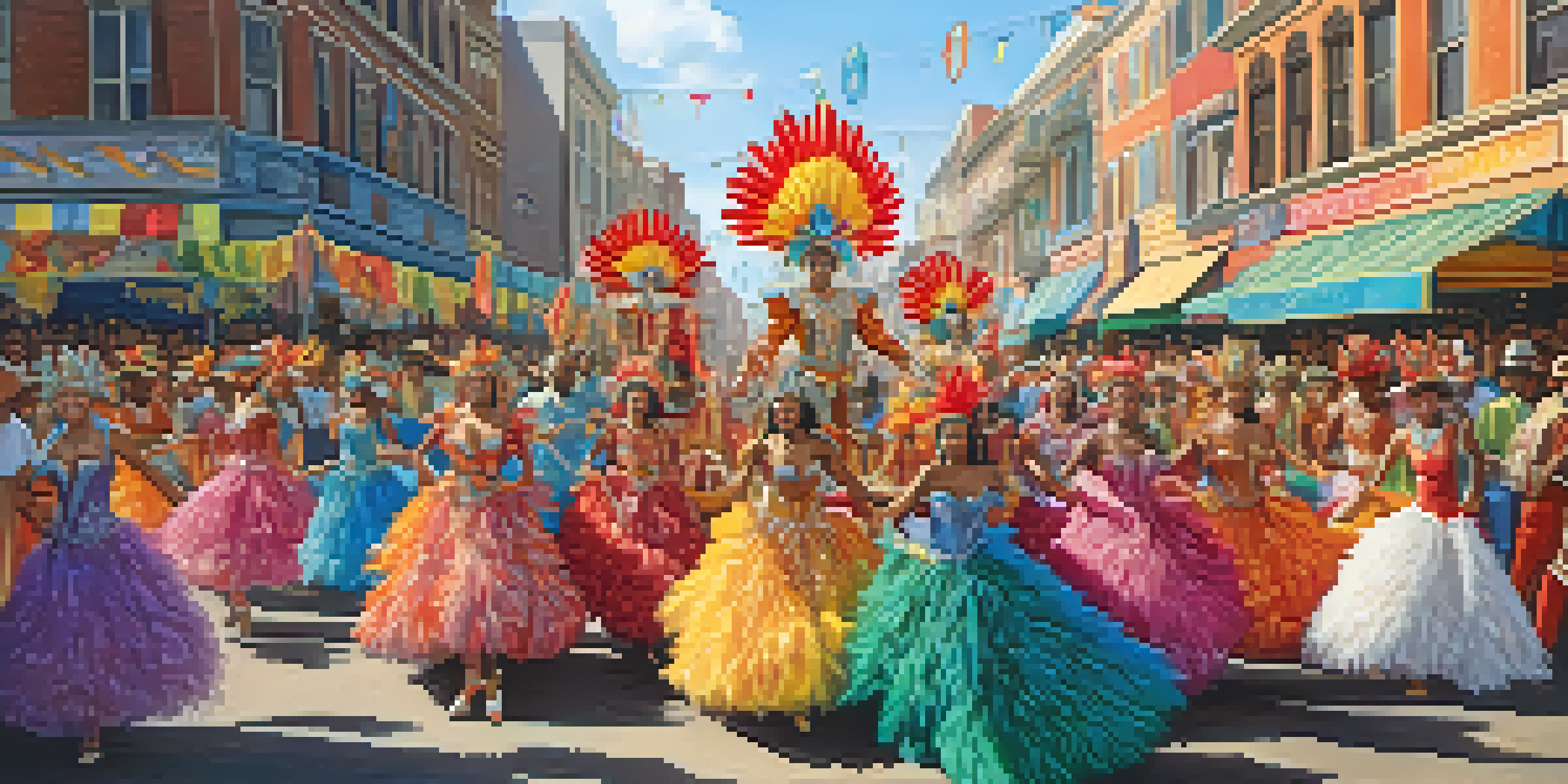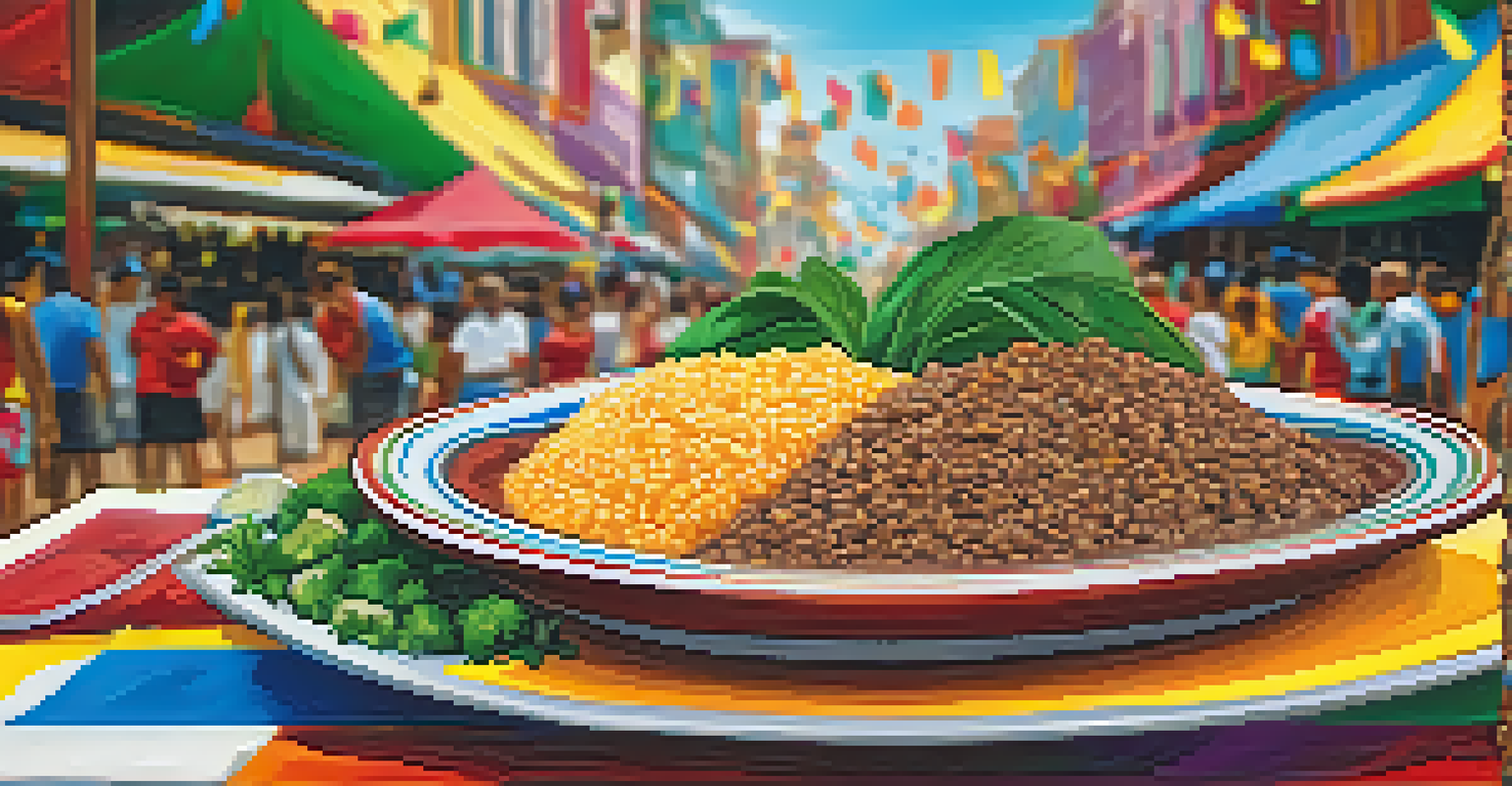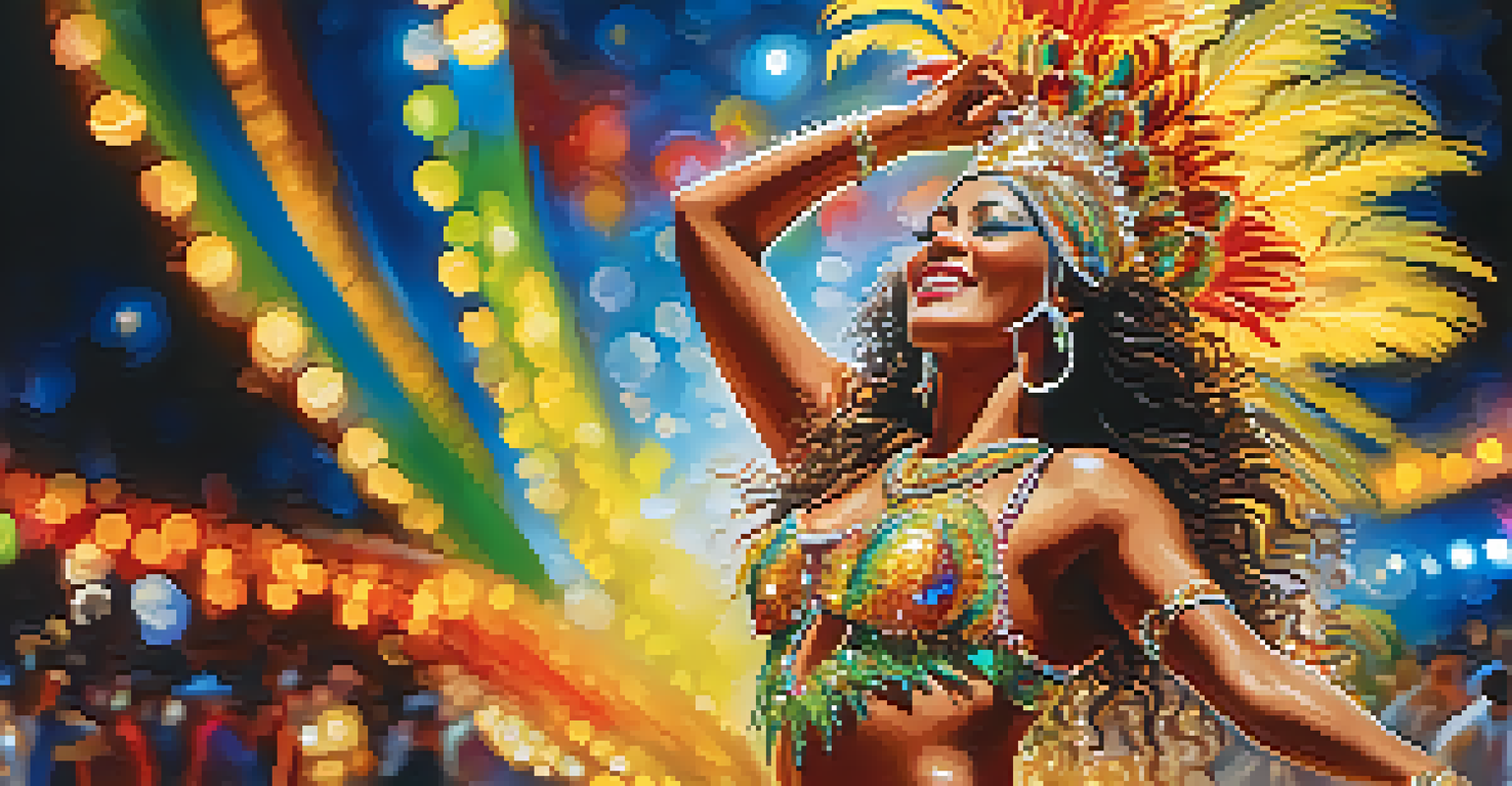Carnaval: A Grand Showcase of Brazilian Folklore and Traditions

The Origins of Carnaval: A Cultural Mosaic
Carnaval has deep roots in Brazil's diverse cultural heritage, blending Indigenous, African, and Portuguese influences. This rich history manifests in vibrant parades and captivating performances that tell stories of the past. Initially a Catholic celebration before Lent, it evolved into a grand festival that showcases Brazil's unique identity. Each region contributes its own flavor, making Carnaval a true cultural mosaic.
Carnaval is not just a festival; it's a powerful expression of Brazilian identity.
The festival's origins can be traced back to the 18th century when European settlers brought their traditions to Brazil. Over time, these customs intertwined with local practices, giving rise to a distinct Brazilian Carnaval. For instance, samba music, which is now synonymous with Carnaval, has African origins and reflects the struggles and joys of the Afro-Brazilian community. This blend of cultures creates a celebration that is both historically significant and incredibly vibrant.
Today, Carnaval is not just a festival; it's a powerful expression of Brazilian identity. It allows communities to celebrate their heritage, showcase their talents, and come together in unity. The festival's ability to adapt and evolve while retaining its core essence speaks volumes about the resilience and creativity of the Brazilian people.
Samba: The Heartbeat of Carnaval
At the center of Carnaval lies samba, a lively rhythm that captivates both dancers and spectators alike. Originating from the Afro-Brazilian community, samba embodies the spirit of Carnaval, inviting everyone to join in the celebration. The infectious beats and captivating melodies create an atmosphere of joy and excitement, making it impossible to resist dancing along. Samba schools prepare year-round, crafting elaborate performances that showcase their artistic flair.

Each samba school tells a story through its parade, often touching on themes of social issues, folklore, or Brazilian history. The creativity displayed in costumes, floats, and choreography transforms the streets into a dazzling spectacle. These parades are not just entertainment; they serve as a platform for cultural expression and community pride. Every performance is a testament to the hard work and dedication of countless individuals who pour their hearts into their art.
Carnaval's Cultural Heritage
Carnaval is a vibrant festival that reflects Brazil's diverse cultural influences, blending Indigenous, African, and Portuguese elements.
As samba rhythms echo through the streets, they bridge generations and backgrounds, uniting people from all walks of life. Whether you're a seasoned dancer or a curious onlooker, the energy of samba invites everyone to partake in the festivities. It's this communal spirit that makes Carnaval a unique experience, fostering connections between participants and spectators alike.
Costumes and Parades: A Visual Feast
One of the most striking features of Carnaval is its extravagant costumes, which are a feast for the eyes. Each outfit is meticulously crafted, often adorned with feathers, sequins, and vibrant colors that reflect the joy of the festival. These costumes tell stories, embodying themes that resonate with the community, from folklore legends to social commentary. Wearing these creations, dancers bring their characters to life, captivating audiences with their passion and creativity.
The festival demonstrates how shared joy can transcend borders, uniting people through music and dance.
The parades themselves are a spectacle, with samba schools competing for the title of best parade in the Sambadrome. Floats are designed to be grand and imaginative, often incorporating elaborate designs that represent the school's theme. As the parade moves through the streets, the energy is palpable, with spectators cheering and celebrating the artistry on display. This combination of costumes and floats creates an immersive experience that leaves a lasting impression on all who witness it.
Beyond the visual spectacle, these parades are a means of cultural storytelling. Each samba school’s performance is a narrative woven through dance, music, and design, allowing the audience to connect with the deeper messages behind the celebration. This artistic expression is a powerful reminder of the creativity and resilience of Brazilian culture, making Carnaval a truly unforgettable experience.
Folklore and Myths: The Stories Behind the Festival
Carnaval is steeped in folklore and myths that enrich its celebrations, weaving tales that have been passed down through generations. These stories often reflect the cultural diversity of Brazil, drawing from Indigenous, African, and European traditions. For instance, figures like Iemanjá, the Afro-Brazilian goddess of the sea, play a significant role during Carnaval, symbolizing protection and fertility. Such figures help to connect the festival to deeper spiritual and cultural significance.
Many samba school parades incorporate elements of folklore, bringing these stories to life through dance and music. This blend of mythology with contemporary performance art allows participants to honor their roots while engaging with modern audiences. The narratives explored during Carnaval often highlight themes of love, struggle, and community, resonating with people from all backgrounds. This storytelling aspect gives the festival a profound emotional depth, making it more than just a visual celebration.
Samba Unites Generations
Samba, the heartbeat of Carnaval, invites participation from all ages and backgrounds, fostering a communal spirit of joy and celebration.
As the festival unfolds, these tales encourage reflection on Brazil's complex history and diverse culture. They foster a sense of belonging and pride among participants, reminding them of their shared heritage. This connection to folklore not only keeps traditions alive but also strengthens the cultural fabric of Brazilian society, ensuring that the essence of Carnaval will endure for generations to come.
Culinary Delights: Flavors of Carnaval
No festival is complete without delicious food, and Carnaval is no exception. Brazilian cuisine plays a vital role in the celebrations, offering a variety of flavors that reflect the country’s rich cultural tapestry. Street vendors line the parade routes, serving up treats like acarajé (black-eyed pea fritters) and pão de queijo (cheese bread) that fuel the festivities. These culinary delights not only satisfy hunger but also create a sense of community as people gather to share meals.
Traditional dishes often tell stories of their own, with recipes that have been passed down through families. The influence of different cultures is evident in the food, blending Indigenous ingredients with African spices and Portuguese techniques. This fusion creates a unique gastronomic experience that complements the vibrant atmosphere of Carnaval. Food becomes a way to connect with heritage, as families and friends come together to enjoy meals that evoke nostalgia and celebration.
As the festival progresses, the flavors of Carnaval enhance the overall experience, making it a feast for all senses. The aroma of grilled meats and sweet desserts mingles with the sounds of samba, creating an unforgettable ambiance. Sharing food during Carnaval fosters camaraderie among participants, reinforcing the festival's spirit of joy and unity. In this way, Brazilian cuisine is not just sustenance; it’s a vital part of the Carnaval celebration.
The Global Influence of Carnaval
While Carnaval is deeply rooted in Brazilian culture, its influence has spread far beyond the country's borders. Cities around the world have adopted their own versions of the festival, celebrating with parades, music, and dance inspired by the original Brazilian Carnaval. From New Orleans' Mardi Gras to the vibrant celebrations in Lisbon, the spirit of Carnaval resonates globally, showcasing the universal appeal of joy and community. These adaptations highlight how cultures can share and celebrate their differences.
Global interest in Carnaval has also led to increased tourism in Brazil, with millions flocking to experience the festivities firsthand. Tourists are drawn to the colorful parades, lively music, and rich traditions that make Carnaval a unique spectacle. This influx of visitors not only boosts the local economy but also fosters cross-cultural exchanges, allowing participants to learn from each other. Such interactions enrich the experience for both locals and tourists, creating lasting memories.
Culinary Delights Enhance Experience
Brazilian cuisine plays a crucial role in Carnaval, offering delicious street food that brings people together and enriches the festive atmosphere.
As Carnaval continues to inspire celebrations worldwide, it serves as a reminder of the power of cultural expression. The festival demonstrates how shared joy can transcend borders, uniting people through music and dance. In this way, Carnaval not only preserves Brazilian traditions but also enriches global culture, inviting everyone to partake in the festivities and celebrate together.
The Future of Carnaval: Tradition Meets Innovation
As Carnaval evolves, it faces the challenge of balancing tradition with modernity. While the core elements remain, new technologies and ideas are shaping the festival's future. Innovations such as social media and live streaming have allowed Carnaval to reach wider audiences, making it more accessible than ever. This connectivity fosters a global community of Carnaval enthusiasts who can engage with the celebrations, regardless of their location.
Moreover, younger generations are introducing fresh perspectives to the festival, incorporating contemporary styles and themes into traditional performances. This infusion of creativity ensures that Carnaval remains relevant and resonates with diverse audiences. Emerging artists and performers are exploring new musical genres and dance styles, pushing the boundaries of what Carnaval can be. This blend of old and new encourages a dynamic dialogue within the festival, keeping its spirit alive.

Ultimately, the future of Carnaval lies in its ability to adapt while honoring its rich heritage. As new generations take the reins, the festival will continue to thrive, reflecting the ever-changing landscape of Brazilian society. By embracing innovation while celebrating tradition, Carnaval will remain a vibrant showcase of culture, unity, and joy for years to come.